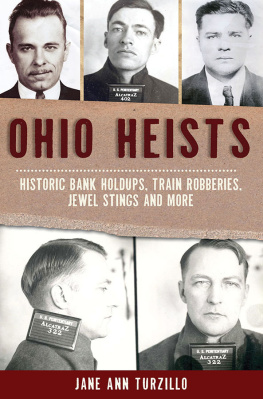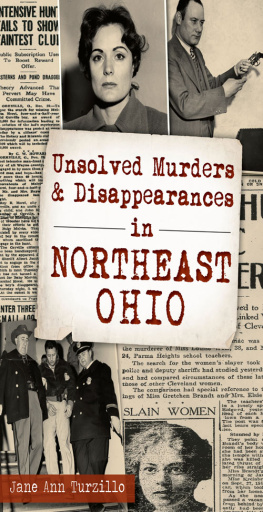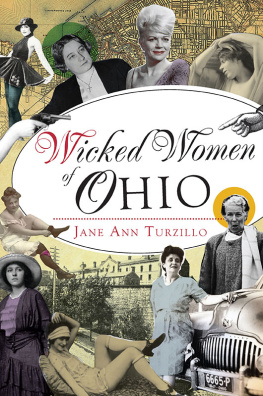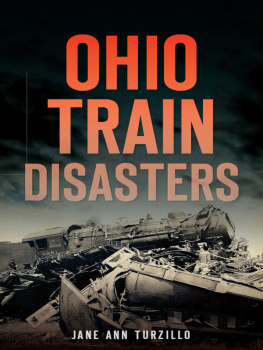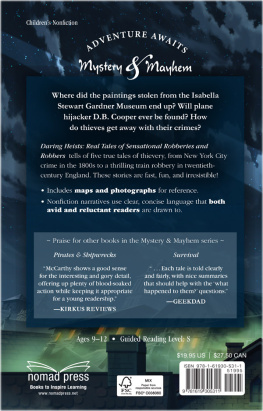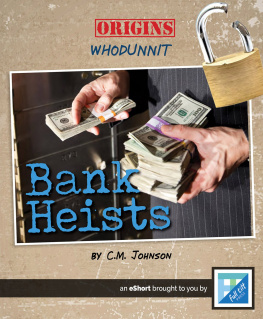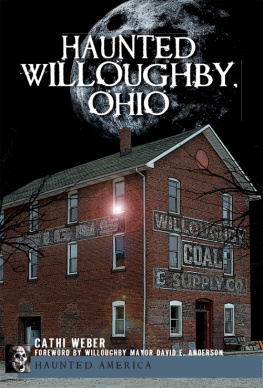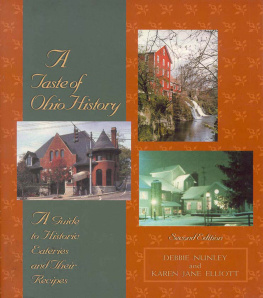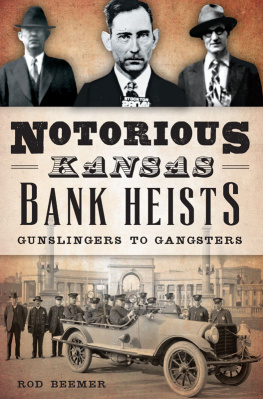

Published by The History Press
Charleston, SC
www.historypress.com
Copyright 2021 by Jane Ann Turzillo
All rights reserved
First published 2021
e-book edition 2021
ISBN 978.1.43967.233.4
Library of Congress Control Number: 2020951644
print edition ISBN 978.1.46714.556.5
Notice: The information in this book is true and complete to the best of our knowledge. It is offered without guarantee on the part of the author or The History Press. The author and The History Press disclaim all liability in connection with the use of this book.
All rights reserved. No part of this book may be reproduced or transmitted in any form whatsoever without prior written permission from the publisher except in the case of brief quotations embodied in critical articles and reviews.
CONTENTS
For my family, with all my love
I dont drink much and I smoke very little. I guess my only bad habit is robbing banks. Now you see, fellas, I aint such a bad guy.
John Dillinger
ACKNOWLEDGEMENTS
Writing can be a lonely job, but not when the project is nonfiction history. It takes some curious librarians, generous historians, knowledgeable beta readers and a supportive family. In addition, it has been my pleasure to work with a great editor, John Rodrigue, for the second time.
Some of the people who helped with research and photos are friends, and some are folks who I met for the first time. Whether they knew me or not, they all wanted to help. Without them, this book would not have been possible. Many, many thanks to Mazie M. Adams, executive director, Cleveland Police Historical Society and Museum; Dale Albright, Norwalk Public Library; David Bailey, Toledo Police Museum; Christopher D. Barth, associate dean and director of libraries and archives, United States Military Academy; Devin Bean, student manager, archives and special collections, Kenyon College; Cleo Bell, senior library services assistant, Genealogy & Local History Department, Public Library of Cincinnati and Hamilton County; Robert J. Cermak, retired commander, Cleveland Police, Cleveland Police Museum; Judith G. Cetina, PhD, Cuyahoga County Archives; James Dailey II, author; Alan Dutka, author; Pete Elliott, U.S. marshal, Northern District of Ohio; John K. Elliott, retired deputy U.S. marshal; Shirley Green, Toledo Police Museum; Caryn Hilfer, executive administrator, Cleveland Plain Dealer; Karen Huck, Montano Historical Society; Wendy Koile, author; Irv Korman, author; Rebecca Larson-Troyer, Akron-Summit County Public Library; Lyndsey, Akron-Summit County Public Library; Brian Meggitt, Photography Collection librarian, Cleveland Public Library; Russell Metcalf; Vern Morrison, Digital Production Unit coordinator, Michael Schwartz Library, Cleveland State University; Carrie Phillips, Bluffton University, Musselman Library; Michael D. Pittman, photographer; Russ Rattray, associate professor, associate library director, H. Raymond Danforth Library (Henniker, New Hampshire); James Renner, author; Abigail Tayse, College & Digital Collections archivist, Kenyon College; and Beth Thieman, Toledo Police Department.
I have my brainstorming group to thank for support and therapy. They are Julie Anne Lindsey, Kathryn Long, Cari Dubiel, Wendy Campbell and Shellie Arnold.
A special thanks to my beta readers, Marilyn Seguin, and my sister, Mary Turzillo, PhD. This is the eighth book theyve critiqued for me.
This book was also made possible by those period journalists whose bylines never appeared at the tops of their stories.
And finally, I want to thank my son, John-Paul Paxton, and my grandsons, Nicholas and Nathan, for their love and encouragement. I am also thankful for the company of my beagle, Wyatt Earp, who lies under my desk while I write, and my German shepherd, Doc Holliday, who is too big to get under my desk, but lies beside my chair.
I hope I have not forgotten anyone. If I have, it was not intentional.
INTRODUCTION
On New Years Day in 2004, I was watching television as I took down the Christmas tree and put away the trimmings. A jewel thief named Bill Mason was being interviewed on Court TV. He was handsome, charming and articulate. Since his crimes were all outside of the statute of limitations, he had authored a book detailing his prolific capers, for most of which he had never been held to account. He had worked as a cat burglar, stealing from the rich and famous in Fort Lauderdale and Pompano Beach, Florida. I knew those towns. They were part of my childhood and teen years. What most interested me was that he started and ended his criminal career around Cleveland. I got my hands on the book, made some notes and tucked the story away, knowing that someday I had to write about him. It was the beginning of my collecting stories of robbers and burglars.
Ted Conrad, a young man from Cleveland, walked away from the bank where he worked with a fifth of Canadian Club, a carton of Marlboros and $215,000 in a paper sack. No one was the wiser for three or four days. Apparently, Ted had been planning the embezzlement for some time. He got the idea from the movie The Thomas Crown Affair. He even began to dress and act like Steve McQueen. Ted had a high IQ and wanted to see if he could get away with it. He did get away with it. I added his story to my files.
I learned about a rare book thief from a fellow conference goer at Malice Domestic 2019. I came home and started to research his crimes. I had read about book thieves before, but until I followed David Breithaupts story of looting the Kenyon College library of rare books and documents, I did not know how lucrative that crime could be.
Cowboy Hill, who had so many aliases that he may have forgotten he was really Joseph Muzzio, was the first robber to use machines (cars) to escape police. He turned up in a historical newspaper. I slid that old clipping into my thickening folder.
Photos from the Cleveland Police Museum showing the first camera installed in a bank piqued my curiosity. The camera led to the arrest of Steven Ray Thomas and his two teenage female accomplices.
Resurrection men were in the business of body snatching. They robbed graves and sold the bodies to medical colleges for research. They ran into grave trouble when they robbed John Scott Harrisons tomb. He was both the son and the father of U.S. presidents.
Some of the deadliest and most flamboyant robbers of the Depression era were John Dillinger, Charles Arthur Pretty Boy Floyd and Alvin Karpis. How could I not include them? It is hard to separate truth from legend with these bandits, but for sure Ohio was a favorite haunt for all three. They crisscrossed the state robbing banks and swapping lead with police.
Adrenaline ran high with all the criminals in this book. Some trusted firepower and fast cars to steal what they wanted and to get away with it. Others relied on their intelligence and cunning. All of these crooks depended on luck. For all but one, luck ran out.
THE PEOPLES BANDIT
John Herbert Dillinger was a folk hero to those who had been hit hardest by the Great Depression. They saw him as a sort of Robin Hood who had nerve and style while robbing the banks that had robbed them of their jobs and homes. Some called him the peoples bandit. He held a grip on the publics imagination as his crimes dominated the front pages of nearly every newspaper in the country.
Dillingers thirteen and a half months of infamy ran from his first bank job in New Carlisle, Ohio, on June 21, 1933, to his violent death in Chicago on July 22, 1934. It included a string of bank and police arsenal robberies, three dramatic jail breaks and gun battles throughout the Midwest. He wielded a stolen Thompson submachine gun and wore a purloined bulletproof vest. His trademark was vaulting over bank counters. Either he or a member of his gang was responsible for the deaths of ten men, including a sheriff, and the wounding of seven others.
Next page
